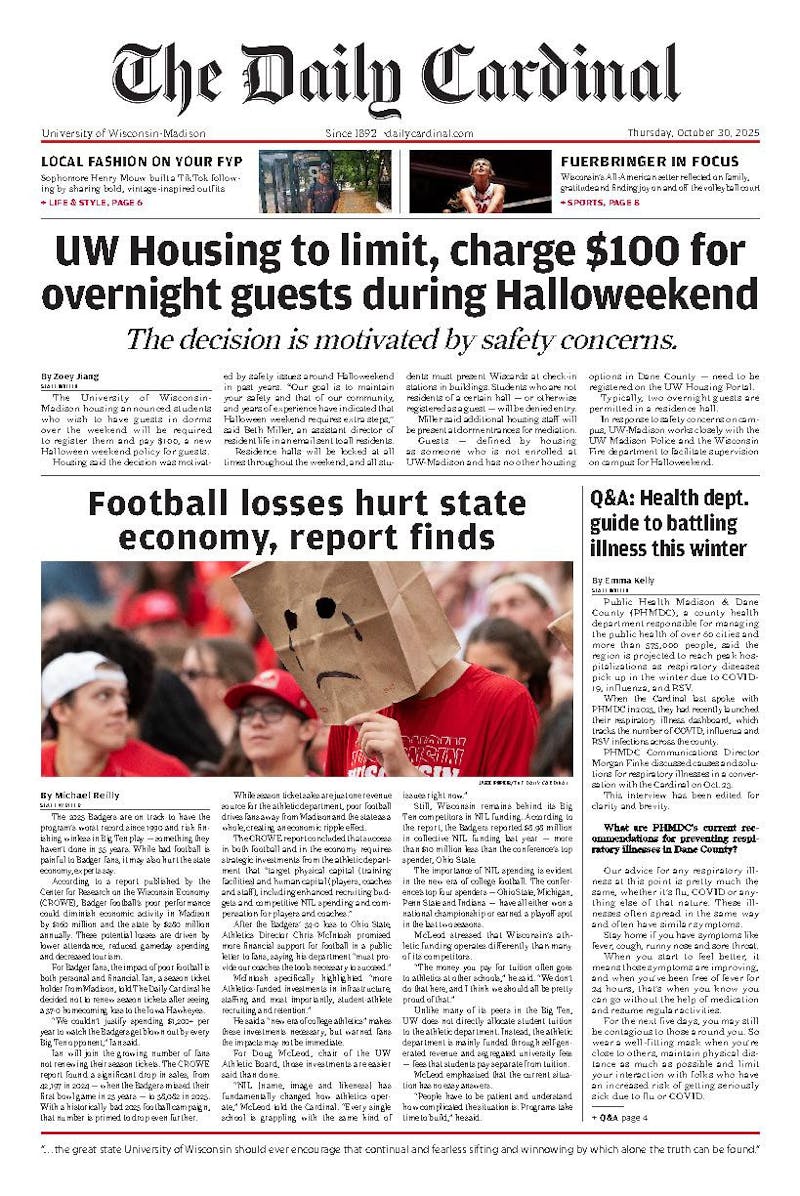When the Badgers’ injury report came out last week before their matchup with Michigan State, it came as a surprise that kicker Rafael Gaglianone would be sitting out. At first glance, it was a huge loss for UW, as Gaglianone has a major impact on the team’s scoring and has plenty of range in his right foot.
The loss left Andrew Endicott with the tall task of kicking field goals, something he hadn’t done since high school. It was a scary proposition.
But despite the vast ability gap between Gaglianone and Endicott, the loss might have actually helped the Badgers, or at least in the hypothetical long-run.
Bear with me for a second. It’s no secret that Paul Chryst is one of the most conservative playcallers in college football. He’s the kind of coach that you’ll never see go for two unless his team is down two with no time left on the clock, and to see him go for it on fourth down is almost just as rare. And that’s exactly why it might have been a positive for the Badgers to lose its reliable kicker.
The math is pretty simple: If going for it on fourth down gives you a better chance of scoring than kicking a field goal does, you should go for it. But just because it’s an obvious concept doesn’t mean it’s clear during the game.
The actual formula for determining whether or not you should go for it is pretty simple. If eP(going for it) > eP(field goal), where eP is expected points, is true, you should keep your offense out on the field. The expected points from kicking a field goal is easy to determine. Just multiply the three points you would gain from making the field goal by the probability of making it.
For example, let’s say the chance of making a 40-yard field goal is 75 percent. This means that in the long run, kicking a 40-yarder will net you 2.25 points on average.
But let’s imagine that you have to decide between kicking that 40-yard field goal and going for it on fourth-and-1. Since you have the ball at the 23-yard line, getting a new set of downs gives your team a pretty good shot of scoring a touchdown.
Historically, teams that have a first down at the 22-yard line (accounting for the one yard you would have to gain to get the first down) score about 3.8 points on average. So now we’ve determined that the value of getting that first down is about 3.8 points, versus the 3 points for making the field goal.
Stick these numbers into another formula that will tell you what the expected points are for each decision: p(get first down) * 3.8 > p(make field goal) * 3. We know that the right side of the equation is 2.25, which means that if you think your team has at least a 59.2 percent chance of getting the first down, you should go for it.
This situation came up early in the Badgers’ game in East Lansing, when the Badgers faced a fourth-and-1 from the Spartans’ 31-yard line. Normally, it seems feasible that Chryst would have sent Gaglianone onto the field to attempt a 48-yard field goal. But the math is clear: Field goals from that distance are made about 60 percent of the time, a long-term yield of about 1.8 points.
But the value of a first down in that situation is about 3.2 points, meaning Chryst only needed to think he had a 56.3 percent chance of converting on that fourth down for it to be the more valuable choice. And given the way UW was manhandling Michigan State at that point, it was likely much higher.
The Badgers went for it and converted for a new set of downs, and finished the drive with a touchdown to take the lead for good.
So even if the Badgers had Gaglianone in the game, going for it would have been the right decision. Having him sit the game out forced Chryst to call more aggressive plays, leading to a maximization of UW’s expected points for the game.
It’s so difficult for coaches to make the call to go for it on fourth down, even if it is the right decision because, should they fail, they are persecuted by angry fans who don’t understand the math. This relationship between uninformed fans and signal-callers forces head coaches to make bad decisions in order to keep their jobs.
It’s a paradox, really; coaches are caught between giving their team the best chance to win and satisfying fans and the media. They can’t have both, but not having both leads to firings.
It’s become nigh impossible for head coaches to make smart decisions in-game, because doing so is a threat to their job security. One thing’s for sure, though: I’m sure as hell glad I’m not a head football coach.






